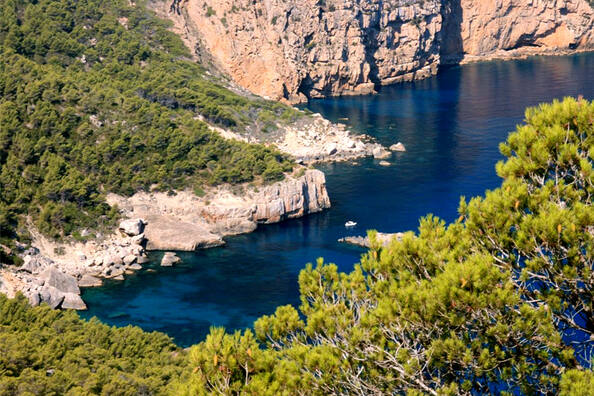Countries<Spain<Illes Balears [Balearic Islands]<Ibiza< Ibiza, biodiversidad y cultura
Ibiza is an excellent example of the interaction between marine and coastal ecosystems, as well as an important testimony to its long history, especially with regard to the Phoenician-Carthaginian and Renaissance periods. It was these exceptional values that led to its recognition as a mixed World Heritage site in 1999.
Since ancient times, this island has been a strategic point on the Mediterranean shipping routes, and with the Phoenicians it began its journey as a trading enclave. Its rich economy, based not only on maritime trade but also on the exploitation of the salt mines, gave rise to the creation of numerous constructions whose traces have survived to the present day. Its strategic position made it the scene of successive struggles for its possession and in 1235 it passed from Arab to Christian hands. Each culture left the echo of its presence, and among them are the settlement of Sa Caleta, an exceptional testimony to the urbanisation and social life of the Phoenician colonies in the western Mediterranean; the necropolis of Puig des Molins, with more than 5,000 tombs that allow us to study the different funerary rituals of the Punic, Roman and Islamic periods; and the walled enclosure of Dalt Vila with great influence on later fortified constructions in the New World. The latter, an example of Renaissance architecture, was commissioned by Philip II to renovate the old medieval walls and turn them into the best-defended bastion in the Western Mediterranean.
To all these cultural elements we must add the natural value of the island, with special attention to the Posidonia Oceanica meadow. This Mediterranean endemism, in an excellent state of conservation, covers the seabed forming meadows that are especially dense in the areas protected by the Marine Reserve and Natural Park of Ibiza and Formentera.
The inseparable relationship between the marine environment that bathes the city and the cultural landscape generated has been the conditioning factor that has encouraged the declaration of this mixed property, a category that has only two examples in our country.
Ibiza constituye un excelente ejemplo de interacción entre los ecosistemas marinos y costeros, al tiempo que un importante testimonio de su dilatada historia, especialmente en lo que se refiere a los periodos fenicio-cartaginés y renacentista. Estos valores excepcionales fueron los que le supusieron el reconocimiento de bien mixto Patrimonio Mundial en el año 1999.
Desde la antigüedad, esta isla ha sido un punto estratégico en las rutas de navegación mediterráneas y con los fenicios comenzó su andadura como enclave mercantil. Su rica economía, basada no solo en el comercio marítimo sino en la explotación de las salinas, dio lugar a la creación de numerosas construcciones cuyas huellas han llegado hasta la actualidad. Su estratégica posición la convirtió en escenario de sucesivas luchas por su posesión y en 1235 pasó de manos árabes a cristianas. Cada cultura dejó el eco de su presencia, y entre ellas cabe destacar el asentamiento de Sa Caleta, testimonio excepcional de la urbanización y la vida social de las colonias fenicias en el Mediterráneo occidental; la necrópolis de Puig des Molins, con más de 5.000 tumbas que permiten estudiar los diversos rituales funerarios de los periodos púnico, romano e islámico; y el recinto amurallado de Dalt Vila con gran influencia en posteriores construcciones fortificadas del Nuevo Mundo. Este último, ejemplo de arquitectura renacentista, se realizó por encargo de Felipe II para renovar las antiguas murallas medievales y convertirlas en el baluarte mejor defendido del Mediterráneo Occidental.
A todos estos elementos culturales debemos añadir el valor natural de la isla, con especial atención a la pradera de Posidonia Oceánica. Este endemismo mediterráneo, en excelente estado de conservación, cubre los fondos marinos formando praderas que son especialmente densas en las áreas protegidas por la Reserva Marina y Parque Natural de Ibiza y Formentera.
La indisociable relación del medio marino que baña la ciudad y el paisaje cultural generado ha sido el condicionante que ha fomentado la declaración de este bien mixto, categoría que cuenta en nuestro país con tan solo dos ejemplos.
